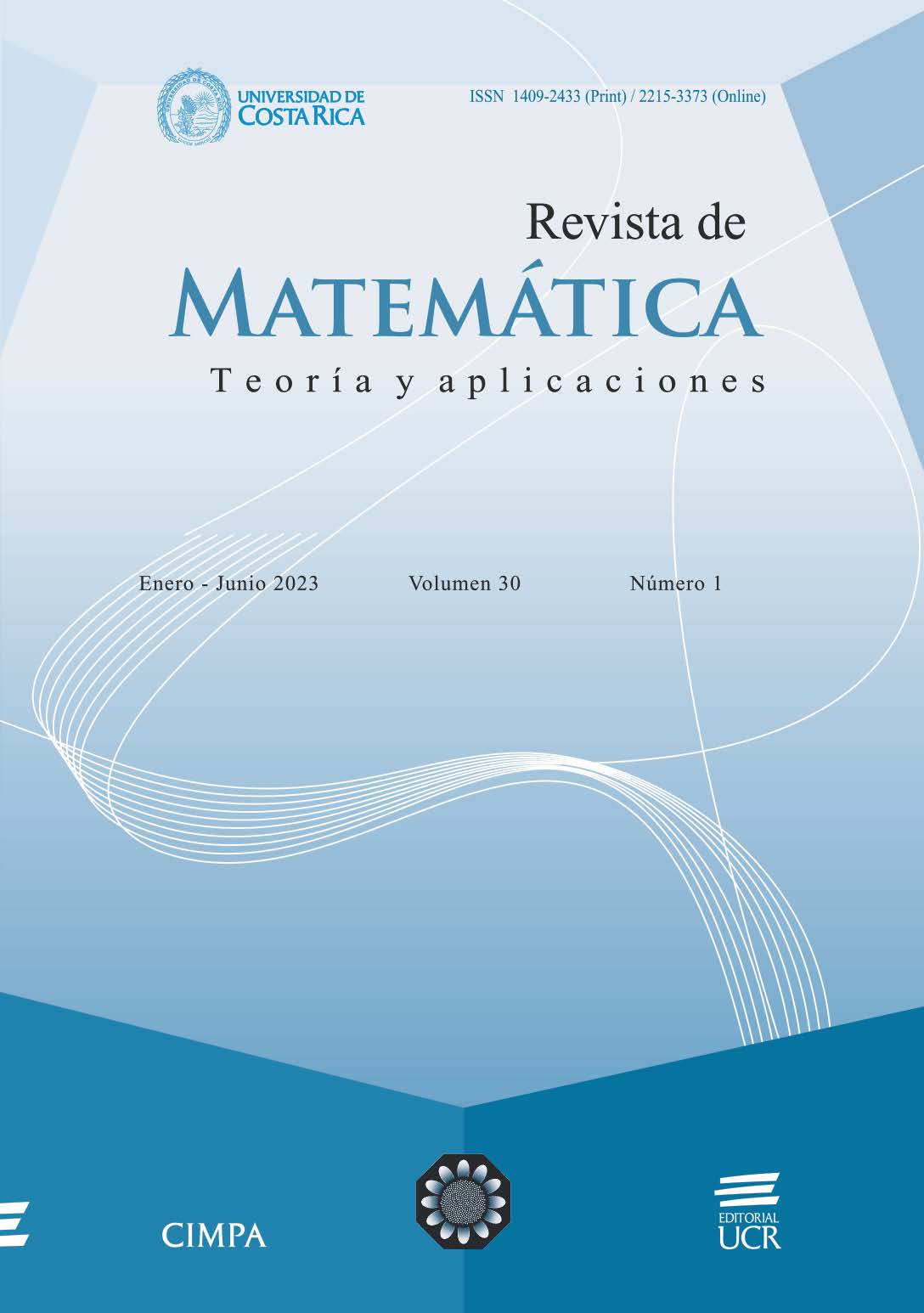Abstract
Different countries used the growth Gompertz function at the beginning of the COVID-19 pandemic to model the number of cumulative infected cases since it provides reasonable results. Such a model allows only one mode, but the pandemic evolution has exhibited a multimodal behavior due to the different waves and variants of the COVID-19 virus. Thus, Gompertz’s classical growth model is not well suited to describe a long pandemic with different virus variants. This work presents generalizations of the Gompertz model that can reproduce a multimodal behavior to model the dynamics of infected cases. The models are applied to COVID-19 data from Nuevo Leon, Mexico.
References
I. Ahmed, G. U. Modu, A. Yusuf, P. Kumam, I. Yusuf, A mathematical model of Coronavirus Disease (COVID-19) containing asymptomatic and symptomatic classes. Results in physics 21(2021), 103776.
M. Catala, D. Pino, M. Marchena, P. Palacios, T. Urdiales, P.-J. Cardona, S. Alonso, D. Lopez-Codina, C. Prats, E. Alvarez-Lacalle, Robust estimation of diagnostic rate and real incidence of COVID-19 for European policymakers. PLoS One 16(2021), no. 1, e0243701. DOI: 10.1371/journal.pone.0243701
S. Coles, An introduction to statistical modeling of extreme values. Springer Series in Statistics. Springer-Verlag London, Ltd., London, 2001, xiv+208. DOI: 10.1007/978-1-4471-3675-0
CONACYT, Estimaciones de la Tasa de Reproduccion Efectiva Rt de COVID-19 para los Estados y Zonas Metropolitanas de Mexico. 2022. URL: https://salud.conacyt.mx/coronavirus/investigacion/productos/. Accessed: 29-Apr-2022, 10:06 a.m.
CONACYT, Vigilancia de variantes del virus SARS-CoV-2. 2022. URL: https://salud.conacyt.mx/coronavirus/variantes/. Accessed: 30-Apr-2022, 11:03 p.m.
C. Gourieroux, J. Jasiak, Time varying Markov process with partially observed aggregate data: An application to coronavirus. J. Econometrics 232(2023), no. 1, 35–51. DOI: 10.1016/j.jeconom.2020.09.007
T. Hastie, R. Tibshirani, J. Friedman, The elements of statistical learning. Springer Series in Statistics. Springer, New York, 2009, xxii+745. DOI:10.1007/978-0-387-84858-7
J. D. Kalbfleisch, R. L. Prentice, The statistical analysis of failure time data.Wiley Series in Probability and Statistics.Wiley-Interscience, Hoboken, NJ, 2002, xiv+439. DOI: 10.1002/9781118032985
J. U. Marquez Urbina, G. Gonzalez Farias, L. L. Ramirez Ramirez, D. I. Rodriguez Gonzalez, A multi-source global-local model for epidemic management. PLoS One 17(2022), no. 1, e0261650. DOI: 10.1371/journal.pone.0261650
A. W. Marshall, I. Olkin, Life distributions. Springer Series in Statistics. Structure of nonparametric, semiparametric, and parametric families. Springer, New York, 2007, xx+782.
L. Martino, D. Luengo, J. Miguez, Independent random sampling methods. Statistics and Computing. Springer, Cham, 2018, xii+280. DOI: 10.1007/978-3-319-72634-2
G. McLachlan, A. Ng, P. Adams, D. C. McGiffin, A. Gailbraith, An algorithm for fitting mixtures of Gompertz distributions to censored survival data. Journal of Statistical Software 2(1997), 1–23. DOI: 10.18637/jss.v002.i07
G. McLachlan, D. Peel, Finite mixture models. Wiley Series in Probability and Statistics: Applied Probability and Statistics. Wiley-Interscience, New York, 2000, xxii+419. DOI: 10.1002/0471721182
G. J. McLachlan, T. Krishnan, The EM algorithm and extensions. Wiley Series in Probability and Statistics. Wiley-Interscience, Hoboken, NJ, 2008, xxviii+359. DOI: 10.1002/9780470191613
Mexican Government, Datos Abiertos Direccion General de Epidemiologia. 2022. URL: https://www.gob.mx/salud/documentos/datos-abiertos-152127. Consulted on 30-Apr-2022, 11:06 p.m.
Mexico’s Secretariat of Health, Sistemas de Informacion de la Red IRAG. 2021. URL: https://www.gits.igg.unam.mx/red-iragdashboard/reviewHome. Consulted on 07-Sept-2022, 11:00 p.
C. Murray et al., Forecasting COVID-19 impact on hospital bed-days, ICU-days, ventilator-days and deaths by US state in the next 4 months. MedRxiv. 2020. DOI: 10.1101/2020.03.27.20043752
J. Nocedal, S. J. Wright, Numerical optimization. Second. Springer Series in Operations Research and Financial Engineering. Springer, New York, 2006, xxii+664. URL: https://www.math.uci.edu/~qnie/Publications/NumericalOptimization.pdf.
J. Pickands, Statistical inference using extreme order statistics. Ann. Statist. 3(1975), 119–131. URL: http : / / links . jstor . org /sici?sici=00905364(197501)3:1%3C119:SIUEOS%3E2.0.CO;2-O&origin=MSN.
M. A. Pinsky, S. Karlin, An introduction to stochastic modeling. Elsevier/Academic Press, Amsterdam, 2011, x+563. DOI: 10.1016/B978-0-12-381416-6.00001-0
S. I. Resnick, Extreme values, regular variation, and point processes. Vol. 4. Springer Science & Business Media, 2008.
H. Rinne, The Hazard Rate: Theory and Inference (with Supplementary MATLAB-Programs). 2014. URL: https://books.google.co.cr/books?id=welNuwEACAAJ.
G. R. Shinde, A. B. Kalamkar, P. N. Mahalle, N. Dey, J. Chaki, A. E. Hassanien, Forecasting models for coronavirus disease (COVID-19): a survey of the state-of-the-art. SN Computer Science 1(2020), no. 4, 1–15.
K. Systrom, Estimating COVID-19’s in Real-Time. 2022. URL: https://github.com/k-sys/covid-19/blob/master/Realtime%20R0.ipynb.
T. M. Therneau, P. M. Grambsch, Modeling survival data: extending the Cox model. Statistics for Biology and Health. Springer-Verlag, New York, 2000, xiv+350. DOI: 10.1007/978-1-4757-3294-8
K. M. Tjorve, E. Tjorve, The use of Gompertz models in growth analyses, and new Gompertz-model approach: An addition to the Unified-Richards family. PloS one 12(2017), no. 6, e0178691. DOI: 10.1371/journal.pone.0178691
C. P. Winsor, The Gompertz curve as a growth curve. Proceedings of the national academy of sciences 18(1932), no. 1, 1–8.
##plugins.facebook.comentarios##

This work is licensed under a Creative Commons Attribution-NonCommercial-ShareAlike 4.0 International License.
Copyright (c) 2023 Revista de Matemática: Teoría y Aplicaciones





